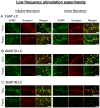SNARE zippering and synaptic strength
- PMID: 24747882
- PMCID: PMC3991612
- DOI: 10.1371/journal.pone.0095130
SNARE zippering and synaptic strength
Abstract
Synapses vary widely in the probability of neurotransmitter release. We tested the hypothesis that the zippered state of the trans-SNARE (Soluble N-ethylmaleimide-sensitive factor Attachment protein REceptor) complex determines initial release probability. We tested this hypothesis at phasic and tonic synapses which differ by 100-1000-fold in neurotransmitter release probability. We injected, presynaptically, three Clostridial neurotoxins which bind and cleave at different sites on VAMP to determine whether these sites were occluded by the zippering of the SNARE complex or open to proteolytic attack. Under low stimulation conditions, the catalytic light-chain fragment of botulinum B (BoNT/B-LC) inhibited evoked release at both phasic and tonic synapses and cleaved VAMP; however, neither BoNT/D-LC nor tetanus neurotoxin (TeNT-LC) were effective in these conditions. The susceptibility of VAMP to only BoNT/B-LC indicated that SNARE complexes at both phasic and tonic synapses were partially zippered only at the N-terminal end to approximately the zero-layer with the C-terminal end exposed under resting state. Therefore, the existence of the same partially zippered state of the trans-SNARE complex at both phasic and tonic synapses indicates that release probability is not determined solely by the zippered state of the trans-SNARE complex at least to the zero-layer.
Conflict of interest statement
Figures


 ) mark the time when test stimuli (Phasic – three single pulses at 0.1 Hz; tonic – three, 200 Hz, 15- pulse trains at 0.1 Hz) were applied following injection, and below each timeline is a diagram depicting the stimulation protocol for phasic and tonic recordings (in B, an example of the high frequency stimulation (HFS) protocol is given from time elapsed mark of 120 min to 180 min). Baseline recording (BR): Phasic – three single pulses at 0.1 Hz every 10 min; tonic – three, 200 Hz, 15-pulse trains at 0.1 Hz every 10 min. High frequency stimulation (HFS): Phasic – burst stimuli of 10 Hz for 2 min with an inter-burst interval of 2 min; tonic – burst stimuli of 150 Hz for 30 sec with an inter-burst interval of 10 sec. INJ – injection, RP – rest period.
) mark the time when test stimuli (Phasic – three single pulses at 0.1 Hz; tonic – three, 200 Hz, 15- pulse trains at 0.1 Hz) were applied following injection, and below each timeline is a diagram depicting the stimulation protocol for phasic and tonic recordings (in B, an example of the high frequency stimulation (HFS) protocol is given from time elapsed mark of 120 min to 180 min). Baseline recording (BR): Phasic – three single pulses at 0.1 Hz every 10 min; tonic – three, 200 Hz, 15-pulse trains at 0.1 Hz every 10 min. High frequency stimulation (HFS): Phasic – burst stimuli of 10 Hz for 2 min with an inter-burst interval of 2 min; tonic – burst stimuli of 150 Hz for 30 sec with an inter-burst interval of 10 sec. INJ – injection, RP – rest period.






References
-
- Atwood HL, Karunanithi S (2002) Diversification of synaptic strength: Presynaptic elements. Nat Rev Neurosci 3: 497–516. - PubMed
-
- Xu-Friedman MA, Regehr WG (2004) Structural contributions to short-term synaptic plasticity. Physiol Rev 84: 69–85. - PubMed
-
- Fiebig KM, Rice LM, Pollock E, Brunger AT (1999) Folding intermediates of SNARE complex assembly. Nat Struct Biol 6: 117–123. - PubMed
-
- Hanson PI, Heuser JE, Jahn R (1997) Neurotransmitter release - four years of SNARE complexes. Curr Opin Neurobiol 7: 310–315. - PubMed
Publication types
MeSH terms
Substances
Grants and funding
LinkOut - more resources
Full Text Sources
Other Literature Sources

